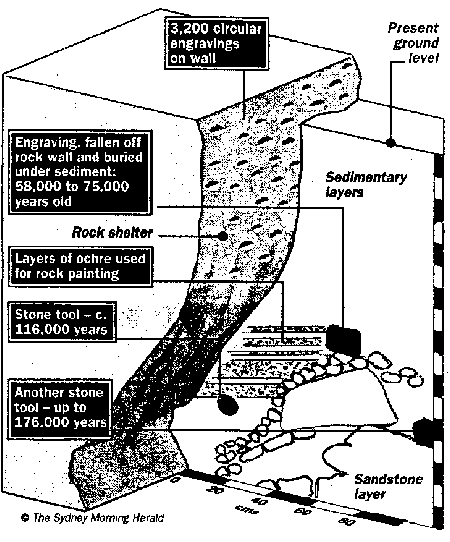 |
Science Frontiers ONLINE No. 110: Mar-Apr 1997 |
|
|
Circles Of Contention
No, this is not about crop circles, although these are easily as controversial -- at least among anthropologists. The story broke last September (1996), in Sydney, Australia, and has been simmering ever since. We have let the story cook for a while, hoping to get some confirmation of the dates involved. This will have to come later.
These "circles of contention" are engraved on tall boulders (about 2 meters high on average) arranged in arcs hundreds of meters long at a site the aborigines call Jinmium. Jinmium is located near the western boundary of Australia's Northern Territory. The circles are obviously the work of humans. There are thousands of these etchings all told. Dimensions: 2-3 centimeters across and about half as deep.
No one doubts that the Jinmium site is ancient. Judging from the sediments that cover the lowest circles, these engravings are about 60,000 years old. If this date survives scrutiny, the Jinmium carvings will be the oldest human art on the planet -- twice as old as anything found in Europe. No wonder the circles have created a stir.
Actually, though, a larger issue is at stake. In the sediments around the engraved boulders, anthropologists have discovered what seem to be even-more-ancient signs of human activity: stone tools stratigraphically dated at 116,000 and 176,000 years. The problem here is that most anthropologists hold (rather fervently) that modern humans did not expand out of Africa until about 100,000 years ago. Paleoanthropologist R. Klein offered the following pertinent comment:
"If it could be demonstrated [that] people were in Australia more than 100,000 years ago, we would have to rethink everything we thought we knew about the later phases of human evolution." (Ref. 1)
If the Jinmium dates do hold up, they would bolster the unpopular "multiregional" hypothesis, which holds that modern humans arose from several protohuman populations -- not just that in Africa. The battle between the "Out of Africa" proponents and the multiregionalists has been a fierce one. The Jinmium artifacts may tilt opinion in favor of the latter. That is why this site is potentially so anomalous.
But, everything hinges on accurate dating. Some of the dating has been done with a relatively new technique called "thermoluminescence" or "TL" dating. Since the Jinmium dates are wildly out of line, we may well see some "adjustments" here.
References
Ref. 1. Holden, Constance; "Art Stirs Uproar Down Under," Science, 274: 34, 1996.
Ref. 2. Woodford, James; "Unearthed: Australia's Lost Civilization," Sydney Morning Herald, September 21, 1996. Cr. R.E. Molnar.
Ref. 3. Bahn, Paul G.; "Further Back Down Under," Nature, 383:577, 1996. Ref. 4. Dayton, Leigh, and Woodford, James; "Australia's Date with Destiny,"
New Scientist, p. 28, December 7, 1996.
Reference. For much more information on archeological anomalies, see our Handbook: Ancient Man. This book is described here.
 | (Left) Sketch of partially buried, etched boulder at Jinmium. (Right) The associated stratigraphy levels and buried artifacts. (Sydney Morning Herald) |